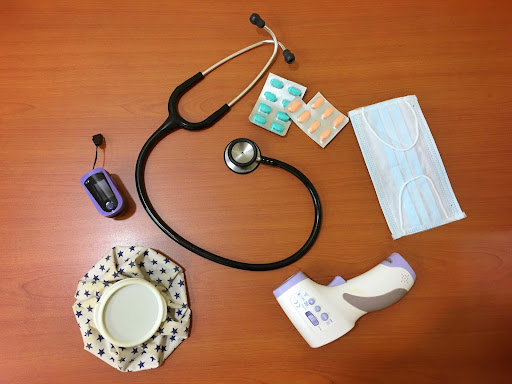Written by: Lindsay Peltsch, RN, BScN
As parents, the health and well-being of our children are our greatest concern. During winter months, infections like influenza, covid, RSV (respiratory syncytial virus), and croup circulate widely among children. For parents, it can seem like a revolving door of fevers and sick days. Understanding what influenza is, its symptoms, how to care for a child that is sick with it. As well as how to keep the rest of your family healthy while doing so is an important part of feeling confident when managing your child’s health.
In this comprehensive guide, we’ll explore everything you need to know about influenza and how to care for your child at home.
What is Influenza?

Influenza, commonly known as the flu, is a viral infection. It can affect individuals of all ages, but children are particularly vulnerable. Influenza is a highly contagious respiratory illness caused by the influenza virus. There are three main strains of the virus Influenza A, B and C. However Influenza A and B are the most common. All subtypes (think H1N1, H3N2) fall under one of these strains.
How does Influenza spread?
It spreads through respiratory droplets. An infected child can spread the virus when they cough, sneeze, talk, or even through breathing close by. Most of the time the incubation period (the time between when a person is exposed to the virus and actually starts to feel sick) is about 1-4 days. With the average being two days. What’s more, if an infected child’s respiratory droplets land on a surface, the virus will live on that for up to 48 hrs, just waiting for you or your child to come along and touch it, and then inadvertently transfer the virus into your mouth or nose.
How Long Does Influenza Survive on Surfaces PARENTS use most?

Non-Porous Surfaces →24 – 48 hours
Think plastic toys, cups, counters, light switches, door handles, faucets, walls, bus poles, cabinets…the list goes on.

Non-Porous Surfaces →24 – 48 hours
Think USED tissues (we all know the pain of being handed a wet snotty tissue), clothes, bedding (pillowcase change anyone?), couches, and winter mittens!
Why are children at higher risk?
Children are more susceptible to getting the flu due to their close interactions in schools and daycare settings. We all know children are not great at keeping their hands OFF surfaces, and OUT of their mouth/nose. This makes it all the easier to both spread and catch the virus.
Thanks to their still developing immune systems, once a child has the virus, they are at higher risk for complications from influenza that can lead to hospitalization or even death. Complications include sinus/ear infections, pneumonia, bronchiolitis, croup, and rarely infection in the brain or heart.
There are also some groups who are at even higher risk of complications:
- Children less than 5 years of age
- Children with asthma or issues that affect their ability to breathe
- Children with underlying medical conditions such as heart disease, or issues that affect their ability to cope with the symptoms of the flu
Common Symptoms & How to tell if its Influenza:
Flu symptoms can vary in severity but generally include:
- High fever
- Cough
- Sore throat
- Runny or stuffy nose
- Muscle or body aches
- Fatigue
- Headache
- Vomiting and diarrhea
These symptoms can be frustrating as they match symptoms of some of the other common winter viruses. Every child experiences the viruses differently and with different severity. But here is a chart to compare what we often see with the common symptoms between RSV, Influenza, and Covid-19

How to care for your child with Influenza
Since Influenza is caused by a VIRUS, antibiotics do not work. If a child has Influenza, we care for them by treating their symptoms and making them more comfortable. Here are a few KixTips to help treat your child’s symptoms…
KixTip 1: Reset
Make sure your child gets plenty of rest to help their body fight the virus. Tired and low energy is ok. As long as they wake and respond to you appropriately they can rest.
KixTip 2: Hydrate
Offer a variety of fluids frequently throughout the day. Small frequent sips of water, clear soups, and oral rehydration solutions will help prevent dehydration. Keep an eye on how often they pee, if they haven’t peed or had a wet diaper in 6 or more hours, check in with your KixNurse!
KixTip 3: Manage Fever
If your child has a fever and they are feeling unwell, give them acetaminophen and/or ibuprofen. Be sure to follow the dosing instructions for the child’s age and weight.
KixTip 4: Treat Cough and Sore Throat
Offer warm liquids, like honey mixed in warm water, to soothe their throat. Note: Avoid giving honey to children under 1 year old.
Tylenol or Advil are not just for fevers! They can also help with sore throats. If you can’t figure out why your child is refusing eating or drinking and they can’t tell you. Try giving some medication and see if they are more willing to eat and drink after an hour or so.
KixTip 5: Clear Nasal Congestion
Use a nasal suction to clear their nose if they’re too young to blow it. Saline nasal drops can also help loosen mucus. Sleep with the window open to let the cool air in. The cool air helps their airway and lessens coughing and secretions.

When to seek medical attention.
While most cases of the flu can be managed at home, there are instances when medical attention is necessary:
- Difficulty Breathing: If your child experiences rapid or difficult breathing, seek medical help immediately.
- Persistent High Fever: A fever lasting more than 5-7 days, even after fever-reducing medication.
- Dehydration: Signs of dehydration include dry mouth, lack of tears, and decreased urination. Contact your KixNurse if your child hasn’t peed in 6-8 hrs.
- Lethargy: If your child is difficult to rouse, not responding normally, not doing developmentally appropriate interactions (e.g.for babies, do they look at you and follow you around the room when awake?)
An Ounce of Prevention….
It’s important to do our best to try and PREVENT infection altogether. We know that we are talking about kids here, so that means that they will still keep touching everything, putting everything in their mouth and keep being… kids!

Try to get your children to wash their hands as often as you can. If they are old enough, giving out hand sanitizer can increase that frequency. Make a rule to wash immediately after getting home from school/daycare, before meals and before bed.
When the viral season is in full swing, make a point to add wiping down high touch areas and kids toys at the end of the day. Wash sick children’s bedding more frequently and clothing more frequently.
The annual flu vaccine is recommended for all children aged six months and older. Vaccination is a key preventive measure against the flu.
The best defense is in the form of the influenza vaccine.
While the vaccine effectiveness changes year to year and can sound low to parents. Even if your child still contracts the virus after vaccination, your child’s symptoms will likely be less severe. Our pediatric experts have seen the toll that influenza can take a toll on children, and advocate strongly for the vaccination of every child.
**Reach out to your family doctor, pharmacist or public health office to find out when and where your child can get their flu vaccine.
Influenza is one of the common seasonal viruses that affect children every winter. By understanding the symptoms, how it’s transmitted, home interventions, when to seek medical attention, and the importance of prevention, parents can confidently care for their children’s health. Remember that every child is unique, so trust your instincts and consult a healthcare professional, or your KixNurse whenever you’re concerned about your child’s well-being.
Want more great content like this?




